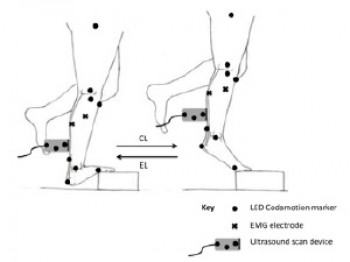Project
A biomechanical characterisation of eccentric (EL) and concentric loading (CL) of the triceps surae
| Primary Investigator: | Dr Saira Chaudhry |
| Co-investigators: | Dylan Morrissey |
| Hazel Screen | |
| Roger Woledge |
EL is commonly adopted as an effective treatment for Achilles tendinopathy, with notably better treatment success compared with CL.
However, there is a lack of consensus about the most appropriate protocols for completing triceps surae exercises. Exercise parameters such as speed and load are important and may affect the stimuli sensed by the muscle-tendon unit and thus influence repair. This project aims to biomechanically characterise and compare EL and CL as a basis for trying to understand treatment effects.
A measuring system comprising motion tracking, 2D ultrasound, force plates and EMG was adopted and a semi-automatic tracking algorithm developed to track the muscle-tendon junction throughout the loading cycle. The effect of variables such as speed of exercise and addition of load were assessed on Achilles tendon force, stiffness, stress, strain and force perturbations as well as muscle activation and contraction frequency, in healthy subjects.
It was found that EL and CL do not differ in terms of tendon force, stiffness or strain. However, EL is characterised by lower muscle activation and by 10 Hz perturbations present within the tendon. These perturbations were found to be significantly dependent on movement speed and load applied during EL movements only. However, no effect of speed was found on tendon force, stiffness and strain during either exercise movement. Finally, temporo-spatial analysis of the calf revealed region specific variations in muscle activation during both EL and CL, with 10 Hz perturbations coming predominantly from medial soleus and medial gastrocnemius muscle activity.
These studies provide new information about the biomechanics of EL or CL, which should enhance understanding, and development, of conservative Achilles tendinopathy management.



